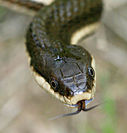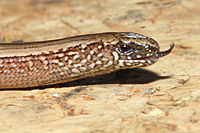Snake
![]()
Snake is a redirect to this article. For other meanings, see Snake (disambiguation) and Snakes (disambiguation).
Snakes (plural of serpent, from Middle High German slange; to slither, writhe, writhe, slither; Ancient Greek ὄφεις ópheis; Latin serpentes, cognate with Ancient Greek ἕρπειν herpein, German 'to crawl') are a suborder of pangolins. They are descended from lizard-like ancestors. Compared to these, the body is greatly elongated and the extremities have been almost completely degenerated. Today, more than 3600 species have been described. With the exception of the Arctic, Antarctic, permafrost regions and some islands, they can be found in all habitats worldwide.
Snakes play a major role in cultural history and mythology and, building on this, in art and literature: in the Old Testament creation story in the Bible, for example, a snake tempted Adam and Eve to taste the fruit from the tree of knowledge. The staff of Asclepius in Greek mythology (Asclepius' staff), entwined with a snake, is still the symbol of the medical and pharmaceutical professions today.
Features
external appearance
All snakes have an elongated and thin body and, with a few exceptions, have completely lost their limbs. Only in the evolutionarily primitive snakes, such as the rolling and blind snakes, there are partly remains of the pelvic girdle and short anal spurs. Body shapes can vary greatly from species to species. Some snakes can look rather stocky and have a thick body with a short tail, for example the Gabon viper (Bitis gabonica), while others thin very evenly towards the back, for example the rough grass snake (Opheodrys aestivus). In cross-section they vary from round or oval to triangular. Almost always the abdomen is flattened. The size of adult snakes varies greatly depending on the species, from 10 centimetres for the slender blind snake (Tetracheilostoma carlae) to almost 7 metres for the reticulated python (Python reticulatus).
Unlike creepers (Anguidae), which have several rows of abdominal shields, snakes have only one row of them. Furthermore, their rostral shield has a small notch at the lower edge (called the rostral notch), which allows them to tongue without having to open their mouths to do so. Sneaks do not have this notch. Snakes also do not have eyelids, their eyes are completely covered by a transparent scale. This is different in creeps, which can be seen in the way they blink. Furthermore, creeps are capable of autotomy, in case of danger they can throw off their tail. This ability also distinguishes them from snakes, although in some evolutionarily old, subterranean snake species the tail can also break off, but there it is a passive process, and moreover it does not grow back.
A distinctly conspicuous sexual dimorphism occurs only very rarely; for example, female adder (Vipera berus) have a rather brown to reddish coloration without a particularly contrasting pattern, the males are rather gray colored and their markings stand out contrastingly from the ground color. Another example are the different scale shapes: the females of the Sipo (Chironius carinatus) have smooth scales, while those of the males are keeled. Other sex-related differences can only be determined by direct comparison: Females are usually slightly larger and more voluminous than males, though it can be the other way around. The base of the tail behind the cloaca is a good distinguishing feature. While it tapers very evenly in the males, a shoulder can be seen in the females.
Snakes have a large number of color and pattern variations. They encompass all colors of the spectrum and can range from monochromatic, with sparsely colored scales, to stripe, ladder, and check patterns, to complex color combinations. Some nonvenomous species have evolved a similar pattern to venomous species during evolution to confuse their enemies and protect themselves (mimicry). Special pigmentations such as albinism and melanism also occasionally occur in snakes.
Skin
Snakeskin consists of three layers: the epidermis, the dermis and the subdermis. All layers fulfil different functions. The epidermis, for example, consists of keratin-containing cells that form a dense and flexible horny layer. This is arranged in the form of scales. The epidermis is the barrier between the snake's body and the environment, through it the animal is quite reliably protected from harmful environmental effects. In the dermis there are nerve endings, connective tissue containing collagen, blood vessels and pigment cells (chromatophores). Here the snake receives tactile sensations and the pigments stored here give it its coloration. The subdermis contains fat bodies in which energy reserves are stored, for example for hibernation or, in ovoviviparous snakes, for the period of gestation.
Shed
→ Main article: Snake scaling
Snake scales are divided into head and body scales. In some species (for example, adders), the head scales are quite large in relation to the body scales and can serve as an identification feature. In plan view, six different head shields can be identified: Scutum rostrale (snout shield, usually present once), Scutum internasale (internasal shield, twice), Scutum praefrontale (forehead shield, twice), Scutum frontale (forehead shield, once), Scutum supraoculare (supraocular shield, twice), and Scutum parietale (parietal shield, twice). There are also various groups of shields in the lateral view of the head, but their number of scales can vary greatly from species to species. These are: Scutum nasale (nasal shield), Scutum loreale (bridle shield), Scutum praeoculare (fore-eye shield), Postoculare (hind-eye shield), Scutum temporale (temporal shield), Scutum supralabiale (upper lip shield), Scutum sublabiale (lower lip shield) and Scutum suboculare (lower eye shield). However, in many other species (for example, the vipers), the head scaling just presented is fragmented into many small scales.
The small body scales on the back and side are usually arranged in the form of longitudinal rows and overlap the respective scale behind them. Again, there are exceptions such as some sea snakes whose scales do not overlap but are arranged side by side; this creates the advantage that marine skin parasites cannot attach well. On the abdomen, the scales extend once across the entire width of the body, so snakes have only one row of abdominal scales. Here, too, the scales overlap those behind them. Scales can be very differently shaped, so there are shiny, dull, smooth or even keeled specimens. Some of them have very special functions; probably the best known example is the tail rattle of the rattlesnake, which consists of special scales formed into horn rings.
A special scale is common to all snake species: this is transparent and serves to protect the eye. Snakes do not have eyelids, their eyes are completely covered by said scale. Under eyelids could penetrate dirt or other foreign bodies, which the animals could not get rid of.
Skinning
Because snakes, like all reptiles, continue to grow throughout their lives even after reaching sexual maturity, but their skin is not continuously shed, as is the case with mammals, for example, they must regularly shed their skin completely. In the process, air penetrates under the dying horny layer and thus slowly detaches it from the rest, which can be seen in a cloudiness or dull colouring of the animals and especially of the eyes. Underlying skin cells grow, form a new skin layer and keratinize a short time later. This means that the animal is never defenceless against possible external influences. Once the keratinization of the new skin is complete, the snake begins to rub its snout against a sharp or pointed object. The old skin tears open and the snake tries to free itself from it while crawling through narrow crevices or branch forks as well as around branches or the like. After moulting, the animals again possess a firm and clearly coloured skin. The cornea of the eyes, which is also desquamated, is now clear again. The old skin, the exuvia, also called "adder shirt", remains behind.
Bone structure
The bones present in snakes can be roughly divided into three groups: Cranial bones, vertebrae and ribs. The already mentioned pelvic girdle bones are rudimentary and serve no further function. Also absent are the shoulder girdle and sternum.
The snake skull is constructed very mobile. Since the jaw and palate bones are not fused together, but only connected by ligaments and are strongly movable, the mouth can be opened very wide. This enables the animals to swallow even larger prey in one piece. The upper jaw consists of the following bones: praemaxillary (the only one firmly connected, above the praefrontale, to the skull), maxilla, wing bone, transverse palatine bone and palatine bone. The mandible consists of two mandibular arches. There is one dental arch in the mandible and two in the maxilla (one internal and one external). These two arches are divided into two, analogous to the mandible. The outer row of teeth is used for catching and holding the prey, the inner one is used for transporting it into the oesophagus. In the process, the left and right arches slide forward alternately, grasp the prey, slide backward with it, and detach from it to slide forward again and start anew. Since all jaw bones can be moved relatively independently of each other, they must be "sorted" again after each bite or prey devouring by opening and closing the mouth several times.
The number of vertebrae is increased to about 200 to a maximum of 435. The vertebral bodies are connected to each other via an intervertebral disc and a joint. The socket lies at the front of the vertebra, the condyle at the back. Inside, they carry the spinal cord and blood vessels in a canal. Although two vertebrae are not capable of bending or twisting very much in relation to each other (as this would risk injuring or tearing the spinal cord), the high number of vertebrae makes them very mobile (with about 40 vertebrae, a bend of about 60° can be achieved). Each vertebra, with the exception of the cervical and caudal vertebrae, bears a pair of ribs. The ribs are connected to the vertebrae by a joint and end freely. The joint allows backward movement from the normal position and a resulting widening of the body. In addition to the extremely mobile cranial bones, this is another prerequisite for the snakes to swallow prey with a larger diameter than their own.
Teeth
The teeth of snakes are not designed for chewing, but serve only to hold the prey or, in the case of poisonous teeth, the injection of toxins. They sit only loosely on the jaw and are not firmly fused to it. All teeth face backwards; if a prey animal tries to free itself from the snake's bite, the teeth only bore deeper into its body. If a tooth breaks off, it is replaced. Usually reserve teeth are already in place behind the existing ones, so the replacement is available in a relatively short time.
With snakes, one finds four different types of the Bezahnung:
- aglyph: Such toothed snakes do not have poisonous teeth. All teeth are about the same size, have the same shape and are evenly distributed in the jaw. There are no special features of the teeth as in the other three dentition types. These non-poisonous snakes include the common vipers (Colubrinae), giant snakes (Boidae), blind snakes (Typhlopidae) and slender blind snakes (Leptotyphlopidae).
- proteroglyph: In this type of dentition, snakes have a pair of poisonous teeth located in the front area of the upper jaw. The venomous teeth are slightly larger and thicker than the rest and have a furrow on their inner side (furrow teeth). The venom glands are located in the connective tissue above; if the snake bites, the venom is directed into the body of the prey animal via the furrow. Representatives of the sea snakes (Hydrophiinae) and poisonous snakes (Elapidae) are proteroglyphically dentate; this also includes the snakes with the strongest venoms, such as the taipans.
- opisthoglyph: The structure of the venomous teeth is comparable to the variant proteroglyph, but in contrast to this the pair of venomous teeth is located in the posterior region of the upper jaw. Opisthoglyphically toothed are the pit vipers.
- solenoglyph: This dentition also has a pair of poisonous teeth in the front of the upper jaw. However, the poisonous teeth are relatively long (between three and five centimetres, depending on the species) and therefore lie folded backwards in a fold of connective tissue when the mouth is closed. The teeth are not grooved, but their interior is - similar to a cannula - traversed by a tube through which the venom is conducted (tubular teeth). As soon as the snake opens its mouth to bite, the venomous teeth fold forward by about 90° and can thus be driven deep into the prey. A great advantage of this is that the venom is also introduced deep into the body. From a purely mechanical point of view, the solenoglyphic dentition is the most effective for injection. All vipers (Viperidae) and pit vipers (Crotalinae) are equipped with such tubular teeth.
· serration
· 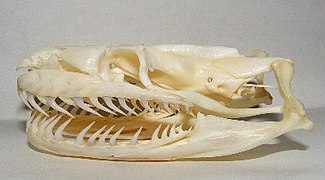
Skull of the aglyphic dark tiger python
· 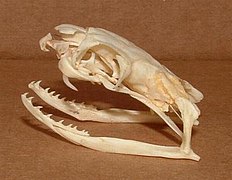
Skull of a proteroglyphic king cobra
· 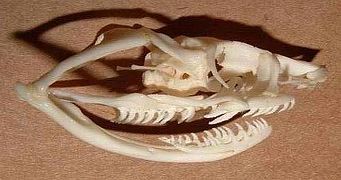
Skull of the opisthoglyphic western hooknose snake
· 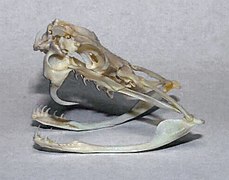
Skull of a solenoglyphic rattlesnake
Sense organs
Snakes are able to perceive and process stimuli from their environment in different ways. What they all have in common is the absorption of odours (volatile substances) via the nose and non-volatile odorous substances with their forked tongue (nasovomeral sense). The forked tongue has inspired people to think about its function in the early past. It is seen in recognizing chemosensitive tracks to follow scents of pheromones or prey. The ability to evaluate two points at the same time improves the ability to differentiate and makes it easier to perceive gradients. Inside the mouth, they guide the tips of their tongues into the Jacobson organ, two small depressions on the roof of the mouth. There, the scents are then analyzed, similar to the smells in the olfactory center. With the two tips, the snakes can simultaneously perceive different scents and extract spatial information from them. This allows them to detect and track prey or sexual partners ready to mate. Consequently, the purpose of frequent licking is to explore their surroundings.
Some species have developed sensory organs for perceiving infrared radiation. Pit vipers have an organ (the eponymous pit organ) that enables them to do this. It is a sensory pit between the eye and the nostril that can register temperature differences of up to 0.003 °C. Giant snakes have a similar organ. The giant snakes have developed a similar organ, with them these are the labial pits. These are located in the scale rows of the upper and lower lip. They are less sensitive than the pit organ and are able to perceive temperature differences of up to 0.026°C. Both infrared sensory organs serve only to detect endothermic prey. These stand out very clearly from their surroundings, despite any camouflage colouration; especially at night, when the difference between ambient and body temperature is even greater than during the day. These sensory organs are not useful for finding ectothermic prey. For this purpose, nasovomeral sense and eyes are used.
The eyes play a role in the sensory perception of snakes mainly in the identification of other snakes (rival or possible sexual partner), other animals (prey or predator) and orientation in space. There are many differently equipped eyes and accordingly the eyesight of the animals varies. Some species (mostly snakes living underground) only have eyes equipped with rods, so they can only detect differences in brightness of objects, not colors. Others have only cones and thus can perceive colors. These species, unless they have infrared receptors, are restricted to daytime activity. The most highly developed eye form has cones and rods; snakes so equipped can theoretically be active at all times, including night and twilight. Furthermore, there are thin and thick cones, which are found in different combinations with the others. However, their mode of operation has not yet been clarified.
The hearing of snakes perceives sound waves transmitted through the air only very poorly or not at all, because there is no outer ear. However, they are able to register vibrations of the ground with their inner ear. The prerequisite for this is that the head rests on the ground. The vibrations are then transmitted to the inner ear via a series of bones connected to the lower jaw. This process is similar to the transmission of acoustic signals through the ossicles in the middle ear of mammals. Since the left and right halves of a snake's lower jaw are not rigid but connected by flexible ligaments, both halves of the lower jaw can be set into vibration independently of each other. This also enables snakes to perceive direction.
If a larger creature approaches the snake, it can judge this by the strength of the vibrations and has usually already fled to a hiding place before the potential enemy reaches it.
Internal organs
The brain is located in the capsule of the skull. Most of their internal organs are elongated according to the body shape. The left lung is usually atrophied or not developed at all, except in Boidae and Xenopeltidae, while the right one can extend over up to two thirds of the body length, in some sea snakes even to the anus. This is also clearly visible from the outside, when the body expands slightly with each breath. In the posterior part, the trachea merges into an air sac (tracheal lung), from which the snake can meet its oxygen needs in special situations (for example, while devouring a large prey animal, which sometimes compresses the trachea, or in sea snakes during long dives). In sea snakes, it additionally serves as a hydrostatic organ. The liver also consists of only the right lobe, but extends over most of the body.
Depending on the preferred habitat, the single-chambered heart is located in different positions. In tree-dwelling (arboricolous) snakes it is located near the head, so that even in a vertical position (for example when climbing a tree) the brain is always sufficiently supplied with blood. The rear part of the body is supplied during this time by the action of the earth's gravitational force, and here a pumping action is not necessary for the supply of blood by the heart. Such a snake can hold the upright position longer than other snakes, but must always return to the horizontal, otherwise a congestion of blood may occur in the posterior part of the body. Ground-dwelling snakes, which only stand upright in exceptional cases such as threatening behaviour, comment fights and the like, have the heart approximately after the first third of the body length. This ensures blood supply to the entire body and the snake is able to erect its front third of the body for a period of time. Sea snakes have their heart about in the middle of their body. Thus, they are able to assume any position in their habitat. If the snake is in an upright or oblique position, the development of a blood stasis is delayed by the pressure of the water from the outside, which supports the pumping action of the heart.
The oesophagus is strongly curled, which causes a high extensibility and allows the absorption of large prey into the body. It should be noted here that the forked tongue plays no role in swallowing, but serves only as a sensory organ (see chapter Sensory Perception). The stomach is also elongated and has muscular walls. It produces the digestive enzymes and extremely strong digestive acids that attack everything except chitin (insect carapace) and keratin (hair, feathers, and claws); these are excreted with the feces.
The testicles and ovaries also have an elongated shape. The mating organ of male snakes is a paired hemipenis. Depending on the species, this is equipped with spines or thorns that serve to hook into the cloaca of the female snake during the mating act. Because of the very different appearance of the hemipenis from species to species, this is an important identification feature.
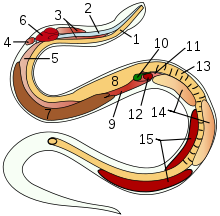
Diagram of the anatomy of a snake: 1 Esophagus 2 Trachea 3 tracheal lung 4 rudimentary left lung 5 right lung 6 heart 7 liver 8 stomach 9 air sac 10 gall bladder 11 Pancreas 12 Spleen 13 Intestine 14 Testicles 15 Kidneys

Similar to this thermal image, the snake perceives warm-blooded prey with its infrared receptors

Labial pits in a python
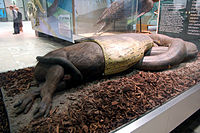
Elongation of the cranial structures illustrated by a specimen
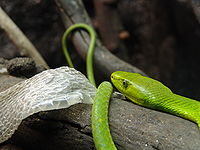
A common mamba (Dendroaspis angusticeps) with stripped skin

Skull bones and rows of teeth of a python

Ventral scales of an angolapython (Python anchietae)
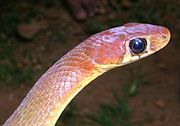
Differences of head and body scales in Amphiesma monticola
Distribution
Snakes are distributed almost worldwide. Their habitats extend approximately between 66° north and 44° south latitude. No snakes have yet been observed outside these latitudes. The most northerly snake is the adder (Vipera berus), which still occurs in northern Fennoscandia. The southernmost limit of distribution is Patagonia - where Cenicienta (Bothrops ammodytoides) is native. Many more remote regions do not have snakes even within the latitudinal range limits. This includes Ireland, Iceland, the Faroe Islands, the Azores, Bermuda, New Zealand and Hawaii.
Habitats
In the course of their evolution, snakes were able to conquer the most diverse habitats. Today we know species that live underground, terrestrially, aquatically (in fresh and salt water) and on trees (arboricolous). Some also represent hybrid forms of the listed lifestyles, such as semi-aquatic/semi-terrestrial. The more diversely structured a habitat is, the more resources and ecological niches it offers, the more snake species have been able to evolve in it; thus, by far the greatest species diversity exists in the tropics, and many of the species living here are endemic. Even seemingly hostile areas such as deserts or high mountains are colonized.
Depending on the habitat, the snakes show different adaptations. These are expressed, for example, in the form of activity rhythms (winter dormancy in temperate zones, year-round activity in the tropical rainforest) or in sexual cycles of varying duration.
Hazard
Based on a long-term study, it was found in 2010 that during the relatively short period of the study, 11 of 17 snake populations in the UK, France, Italy, Nigeria and Australia had declined sharply. Similar declines had previously only been observed in birds and amphibians. Complex causes are suspected, including deteriorations in habitat condition as well as prey availability. However, snake populations also declined in protected areas where habitats are stable. Based on correlation with climate data, global warming could be one of the causes. Because of the role of snakes as predators, a broad population decline would have strong impacts on many ecosystems.
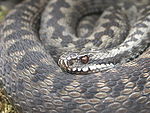
The adder (Vipera berus) is the most common venomous snake in Central Europe.
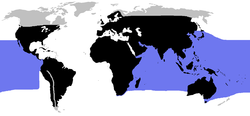
The worldwide distribution of snakes, black: terrestrial species, blue: marine species
.jpg)
The grass snake (Natrix natrix) is a common non-poisonous snake found in Europe.
Questions and Answers
Q: What is the scientific order of snakes?
A: Snakes are part of the scientific order Squamata.
Q: How many species of snake exist?
A: There are approximately 3,400 species of snake.
Q: When did the earliest known fossils of snakes appear?
A: The earliest known fossils of snakes appeared in the Jurassic period, which was between 143 and 167 million years ago.
Q: What special features do snakes have on their bodies?
A: Snakes have overlapping scales which protect them and help them move and climb trees. The scales may also be camouflage or warning colours. They also have skulls with more joints than their lizard ancestors, allowing them to swallow prey much larger than their heads. Additionally, they have no eyelids or external ears.
Q: Where do most snakes live?
A: Most snakes live in tropical areas, but some can live beyond the Tropic of Cancer or Tropic of Capricorn, and one species lives beyond the Arctic Circle. They can also be found living on land, in trees, in water, and even under soil.
Q: How do snakes control their body temperature?
A: Like other reptiles, snakes are ectotherms and control their body temperature by moving in and out of direct sunlight - this is why they are rare in cold places.
Q: What is the size range for different types of snake?
A:Snakes range in size from 10 cm (4 inches) long to 6 meters (22 feet 8 inches) long - with an extinct species reaching 12 meters (42 feet).
Search within the encyclopedia
